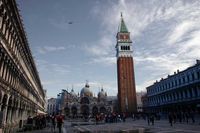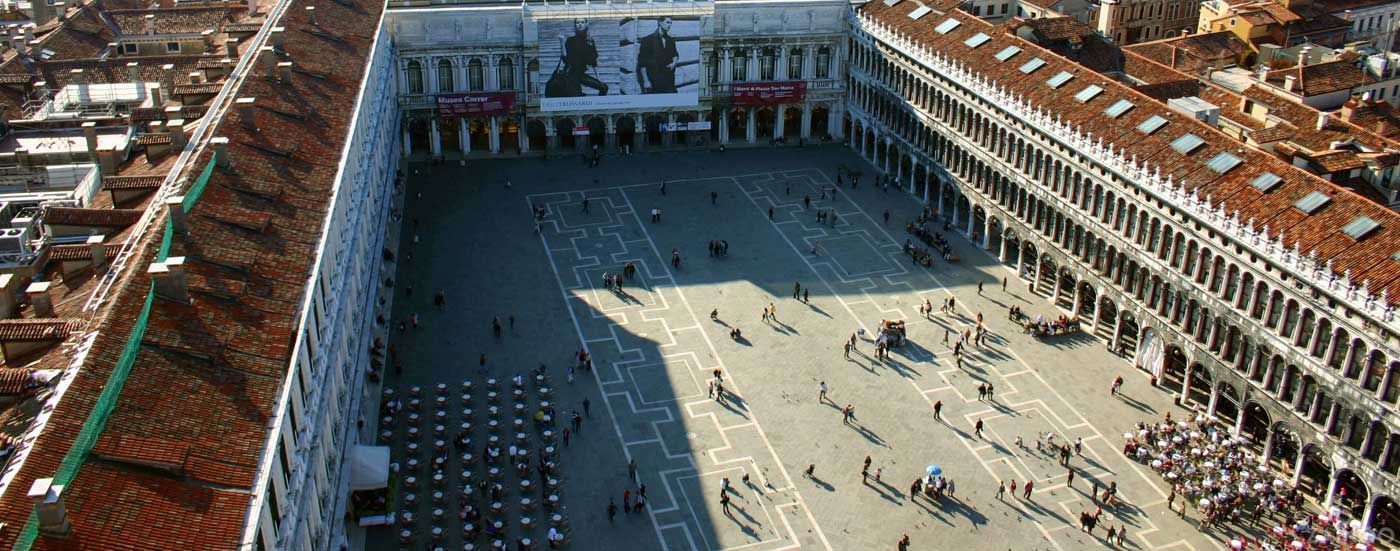St. Mark's Square (Piazza San Marco)
Square
St. Mark’s Square (Piazza San Marco)
The central square in Venice
Even Napoleon called the Piazza San Marci the most beautiful reception room in all Europe. All who entered the city of Venice in the past, did so at St. Mark’s Square, where the ships brought in the visitors. The ambiance of this magnificent square is incomparably beautiful. Lined with beautiful historic buildings such as the St. Mark’s Basilica, the Doge’s Palace and the Procuracies. High above everything else stands the imposing Campanile.
The history of St. Mark’s Square is long. Previously, the square was traversed by a canal and was used as a growing area for fruits and vegetables. In 1174 the Venetians filled in the canal and paved it over with bricks in 1267. Since this time, it has been the religious, political and social centre of Venice. The white marble lines across the square are from the 18th century and mark the locations of the market stalls, which were located here during the week when a large market took place. Today St Mark’s Square is both ballroom and boulevard. The vast majority of visitors of Venice begin or end their visit of Venice here and enjoy one or two coffees in one of the famous square cafes.
Around St. Mark’s Square
The old and new procuracies border the square to the north and south of the piazza. They were once seat of the procurators, who where responsible for the church property and later also for the entire municipal administration. The Procuratie Vecchie, the old procuracy is from the early 16th century. Due to increasing human resource requirements at the beginning of the 17th century the Procuratie Nuove were built on the opposite side. The Museo Correr is also located here. The two procuracies are connected by the Ala Napoleonica which was built 1810 at the request of Napoleon. To the east, the Piazza San Marco is limited by the St. Mark’s cathedral and the St. Mark’s tower.
Mauro Coducci built the Torre dell’Orologio in 1499 to complete the old procuracy. It is a huge clock tower above the doorway at the north end of the square. A visit and brief stop at one of the three famous cafes at St. Mark’s Square is also recommended. Caffè Florian, which dates from the 18th century is the oldest café in the square, Caffè Quadri dates from the 19th century and Caffè Lavena was built in the style of the Habsburg imperial time.
The Piazzetta San Marco
The Piazezetta San Marco between the Doge’s Palace and the National Library is Venice’s reception room. The majority of the visitors entered the city and were welcomed by the Venetians here. At the head of the square, facing the lagoon, two huge granite columns, the Colonne di Marco e Teodoro, border the Piazzetta San Marco. The Doge Michieli brought them once from a trip to Lebanon and erected them there. Originally there were three columns but one of them fell into the sea during unloading. The two columns are crowned by the Venetian Lion of St. Mark and St. Theodore, the original patron saint of Venice. Traditionally public executions took place between the columns in the past – this is the reason why superstitious Venetians would never pass between them.
The Biblioteca Nazionale Marciana, the Marcus library or Liberia Sansoviniana, is located at the entrance to the small square opposite the Palazzo Ducale. It is a masterpiece by Sansovino and was completed after his death by Vincenzo Scamozzi. The magnificent rooms are accessible by guided tours and include in addition to outstanding paintings of Venetian artists also an archaeological museum and a library with over 750,000 volumes.
Accessibility
Landing stage: Vallaresso San Marco or San Zaccaria











Tweet